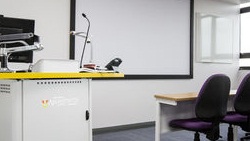Manual Handling
 Manual handling relates to the moving of items either by lifting, lowering, carrying, pushing or pulling. Bad manual handling techniques causes injuries, with manual handling being the single biggest cause of incidents resulting in over seven day incapacitation of workers.
Manual handling relates to the moving of items either by lifting, lowering, carrying, pushing or pulling. Bad manual handling techniques causes injuries, with manual handling being the single biggest cause of incidents resulting in over seven day incapacitation of workers.
The Risks
Handling heavy or awkwardly-shaped objects has the risk of causing injury, especially to your back. The weight of the item is an important factor, but many other factors can create a risk of injury, for example the number of times you have to pick up or carry an item, the distance you are carrying it, where you are picking it up from or putting it down (picking it up from the floor, putting it on a shelf above shoulder level) and any twisting, bending stretching or other awkward posture you may adopt while doing a task. As a result, use mechanical lifting aids wherever possible, or get help from someone else.
The local risk assessments for activities involving manual handling will identify the hazards and the evaluate the appropriateness of the control measures to be implemented. Colleagues should raise any concerns relating to manual handling with their Line Manager immediately.
Training
The Health, Safety and Environment Team delivers a 2 hour Manual Handling Training course which provides delegates with an understanding of the risks associated with manual handling, developing a risk assessment, and ensuring that appropriate control measures are implemented.
Delegates will recognise manual handling hazards, understand the types of injury that can be caused by poor manual handling practice, and practise the best ways to handle loads to maintain a safe working environment.
Good Handling Techniques
Colleagues should consider the following techniques when undertaking any type of manual handling activity:
- stand reasonably close to the load, feet hip-width apart, one foot slightly forward pointing in the direction you are going;
- bend your knees and keep your back straight;
- get a secure grip on the load;
- breathe in before lifting as this helps to support the spine;
- keep the load close to your body;
- do not carry a load that obscures your vision;
- lift slowly and smoothly;
- avoid jerky movements;
- avoid twisting your body when lifting or carrying a load;
- when lifting to a height from the floor, do it in two stages;
- when two or more people lift a load, one person must take control to co-ordinate the lift.
Online Resources
The Health and Safety Executive (HSE) have developed tools to help employers analyse lifting, carrying and team handling (the MAC tool and the V-MAC tool), repetitive upper limb tasks (the ART tool) and pushing and pulling (the RAPP tool). Depending on the task, you may find it helpful to use more than one tool, for example you may need to pick up a box of items (lifting), carry it to a workstation (carrying), then distribute the contents to other locations such as pigeon holes or a filing cabinet (repetitive movements).
- Manual handling assessment charts (the MAC tool) - for lifting, carrying, lowering
- Variable manual handling assessment chart (V-MAC) tool - for when load weights vary
- Assessment of Repetitive Tasks (ART) tool - for repetitive upper limb tasks
- Push/Pull tool (RAPP) – for moving loads by pushing and pulling
- Move IT (Interactive manual handling course - Birkbeck College. Requires 'Flash')
Further Information
- Manual handling at work: A brief guide (Health and Safety Executive)
- Codi a chario yn y gwaith: Canllaw cryno (Awdurdod Gweithredol Iechyd a Diogelwch)
- Manual Handling: Guidance on Regulations (Health and Safety Executive)
- Health and Safety Executive Lifting Guides
- Making the best use of lifting and handling aids (Health and Safety Executive)
- Manual handling assessment charts (the MAC tool)

 Manual Handling Training Course
Manual Handling Training Course Forthcoming Courses
Forthcoming Courses Register an Interest
Register an Interest